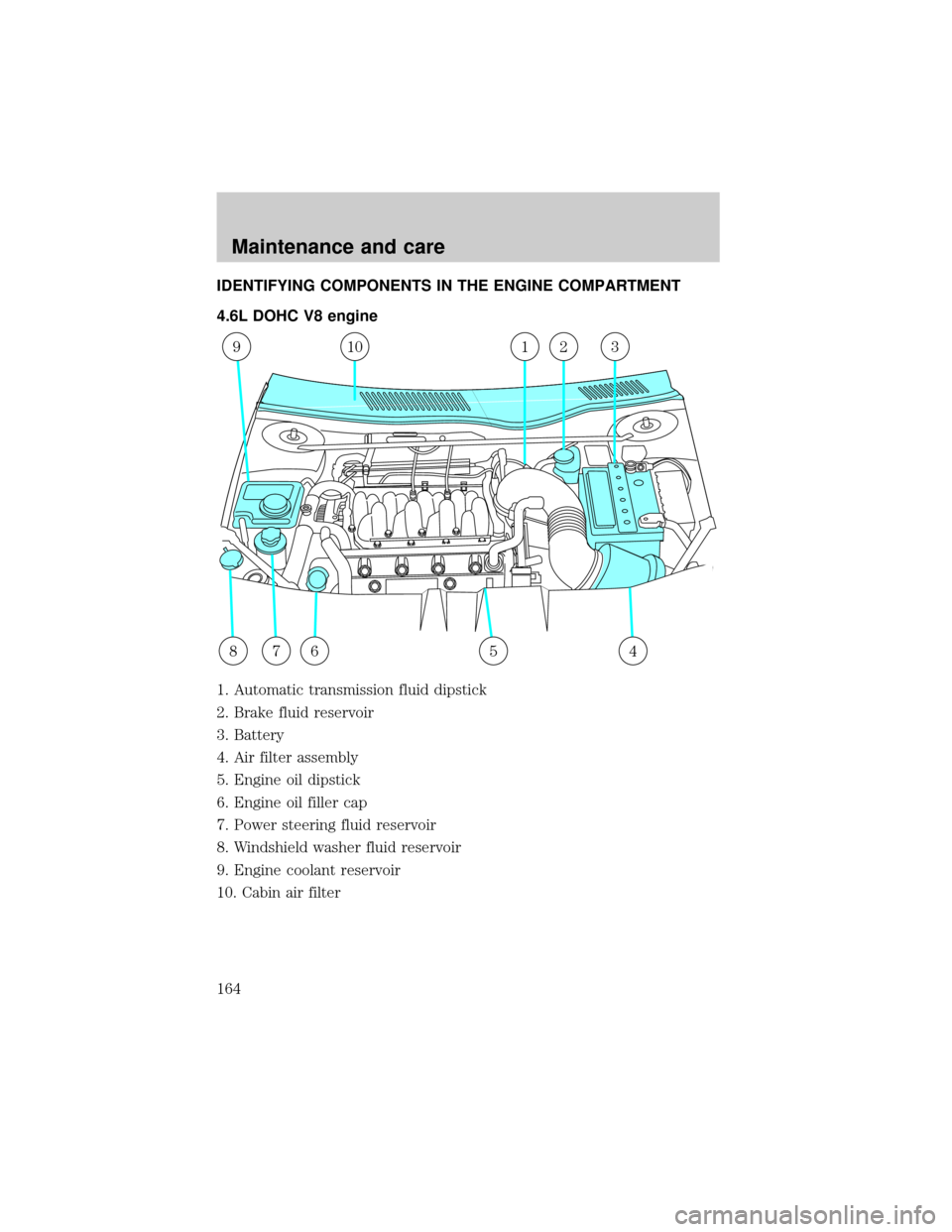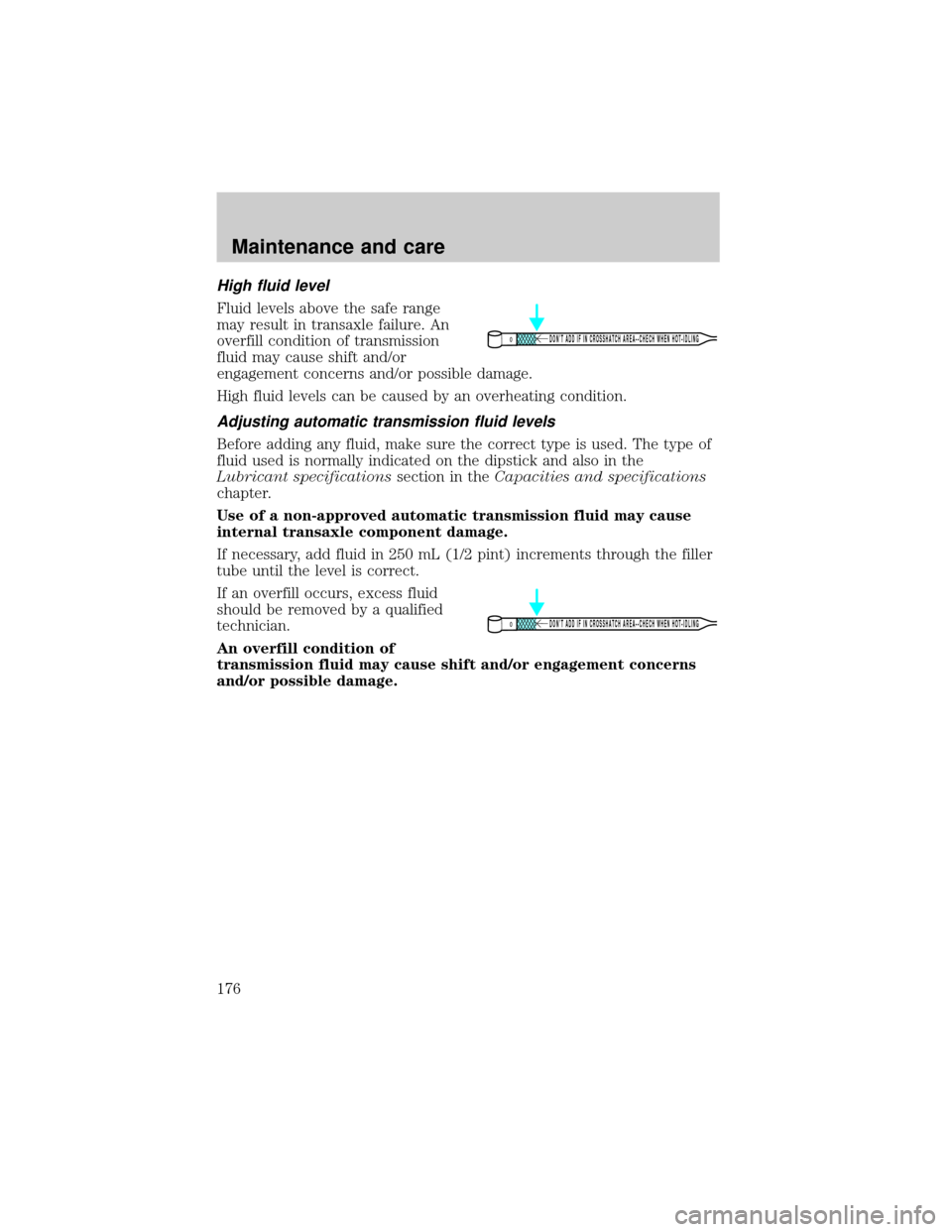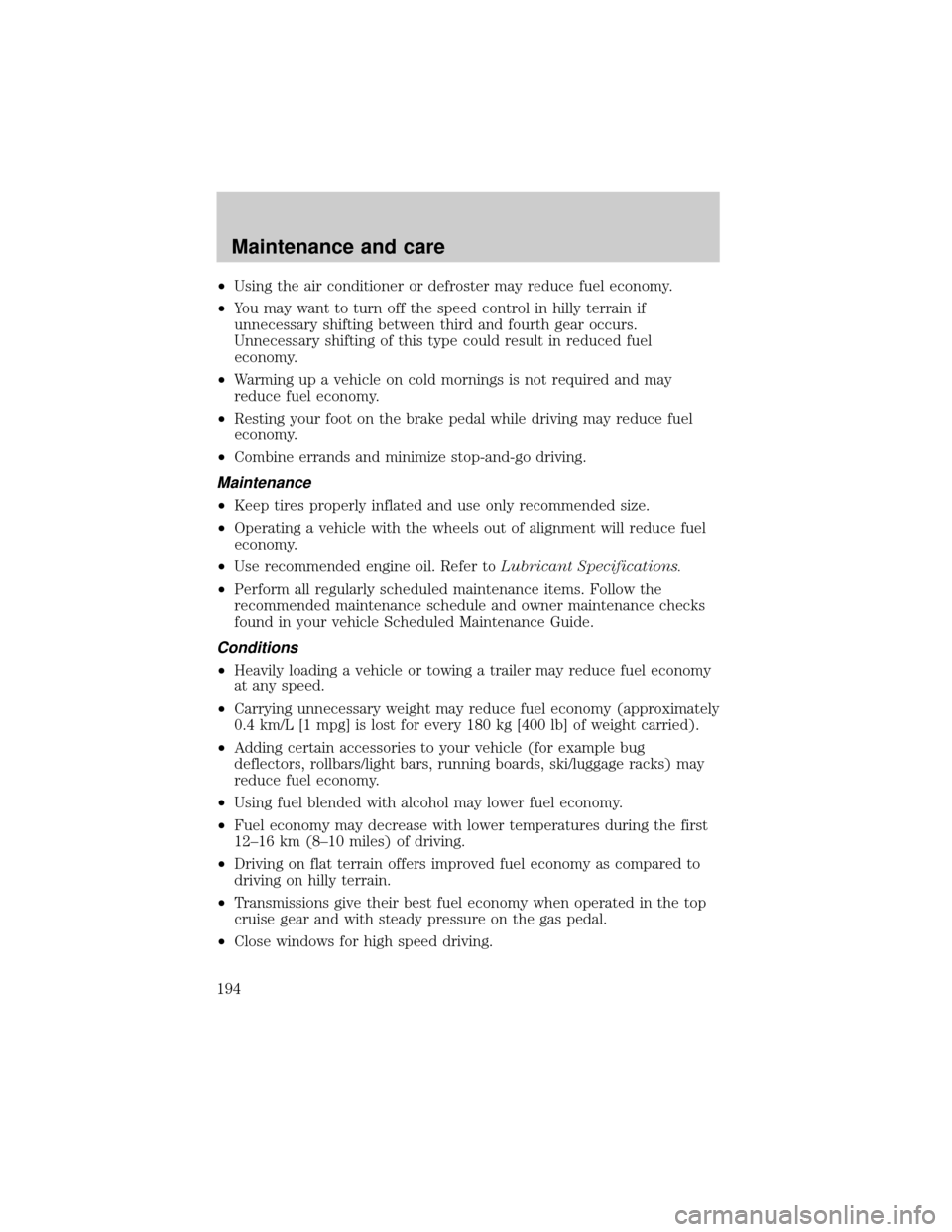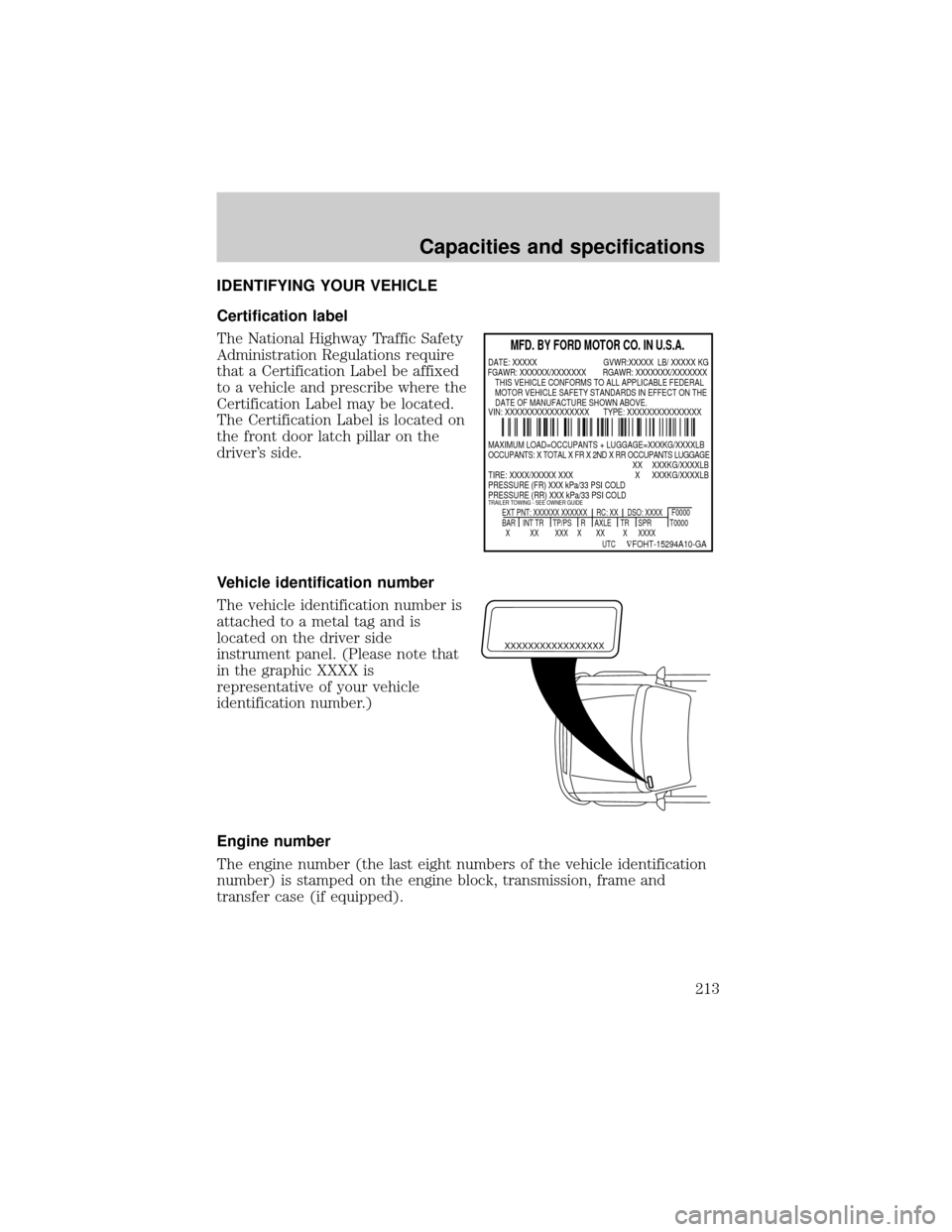2000 LINCOLN CONTINENTAL transmission
[x] Cancel search: transmissionPage 164 of 232

IDENTIFYING COMPONENTS IN THE ENGINE COMPARTMENT
4.6L DOHC V8 engine
1. Automatic transmission fluid dipstick
2. Brake fluid reservoir
3. Battery
4. Air filter assembly
5. Engine oil dipstick
6. Engine oil filler cap
7. Power steering fluid reservoir
8. Windshield washer fluid reservoir
9. Engine coolant reservoir
10. Cabin air filter
910
5
213
4678
Maintenance and care
164
Page 174 of 232

CHECKING AND ADDING POWER STEERING FLUID
Check the power steering fluid.
Refer to the Scheduled Maintenance
Guide for the service interval
schedules. If adding fluid is
necessary, use only MERCONtAT F.
1. Start the engine and let it run until it reaches normal operating
temperature (the engine coolant temperature gauge indicator will be
near the center of the normal area between H and C).
2. While the engine idles, turn the steering wheel left and right several
times.
3. Turn the engine off.
4. Check the fluid level in the
reservoir. It should be between the
MIN and MAX lines. Do not add
fluid if the level is in this range.
5. If the fluid is low, add fluid in small amounts, continuously checking
the level until it reaches the range between the MIN and MAX lines. Be
sure to put the cap back on the reservoir.
TRANSMISSION FLUID
Checking automatic transmission fluid
Refer to your Scheduled Maintenance Guide for scheduled intervals for
fluid checks and changes. Your transaxle does not consume fluid.
However, the fluid level should be checked if the transaxle is not working
properly, i.e., if the transaxle slips or shifts slowly or if you notice some
sign of fluid leakage.
Maintenance and care
174
Page 175 of 232
![LINCOLN CONTINENTAL 2000 Owners Manual Automatic transmission fluid expands when warmed. To obtain an
accurate fluid check, drive the vehicle until it is warmed up
(approximately 30 km [20 miles]). If your vehicle has been
operated for an LINCOLN CONTINENTAL 2000 Owners Manual Automatic transmission fluid expands when warmed. To obtain an
accurate fluid check, drive the vehicle until it is warmed up
(approximately 30 km [20 miles]). If your vehicle has been
operated for an](/manual-img/15/6878/w960_6878-174.png)
Automatic transmission fluid expands when warmed. To obtain an
accurate fluid check, drive the vehicle until it is warmed up
(approximately 30 km [20 miles]). If your vehicle has been
operated for an extended period at high speeds, in city traffic
during hot weather or pulling a trailer, the vehicle should be
turned off for about 30 minutes to allow fluid to cool before
checking.
1. Drive the vehicle 30 km (20 miles) or until it reaches normal operating
temperature.
2. Park the vehicle on a level surface and engage the parking brake.
3. With the parking brake engaged and your foot on the brake pedal,
start the engine and move the gearshift lever through all of the gear
ranges. Allow sufficient time for each gear to engage.
4. Latch the gearshift lever in P (Park) and leave the engine running.
5. Remove the dipstick, wiping it clean with a clean, dry lint free rag. If
necessary, refer toIdentifying components in the engine compartment
in this chapter for the location of the dipstick.
6. Install the dipstick making sure it is fully seated in the filler tube.
7. Remove the dipstick and inspect the fluid level. The fluid should be in
the designated areas for normal operating temperature.
Low fluid level
Do not drive the vehicle if the fluid
level is at the bottom of the dipstick
and the outside temperatures are
above 10ÉC (50ÉF).
Correct fluid level
The transmission fluid should be checked at normal operating
temperatures 66ÉC-77ÉC (150ÉF-170ÉF) on a level surface. The normal
operating temperature can be reached after approximately 30 km (20
miles) of driving.
The transmission fluid should be in
this range if at normal operating
temperature (66ÉC-77ÉC
[150ÉF-170ÉF]).
DON’T ADD IF IN CROSSHATCH AREA--CHECH WHEN HOT-IDLING
DON’T ADD IF IN CROSSHATCH AREA--CHECH WHEN HOT-IDLING
Maintenance and care
175
Page 176 of 232

High fluid level
Fluid levels above the safe range
may result in transaxle failure. An
overfill condition of transmission
fluid may cause shift and/or
engagement concerns and/or possible damage.
High fluid levels can be caused by an overheating condition.
Adjusting automatic transmission fluid levels
Before adding any fluid, make sure the correct type is used. The type of
fluid used is normally indicated on the dipstick and also in the
Lubricant specificationssection in theCapacities and specifications
chapter.
Use of a non-approved automatic transmission fluid may cause
internal transaxle component damage.
If necessary, add fluid in 250 mL (1/2 pint) increments through the filler
tube until the level is correct.
If an overfill occurs, excess fluid
should be removed by a qualified
technician.
An overfill condition of
transmission fluid may cause shift and/or engagement concerns
and/or possible damage.
DON’T ADD IF IN CROSSHATCH AREA--CHECH WHEN HOT-IDLING
DON’T ADD IF IN CROSSHATCH AREA--CHECH WHEN HOT-IDLING
Maintenance and care
176
Page 194 of 232

²Using the air conditioner or defroster may reduce fuel economy.
²You may want to turn off the speed control in hilly terrain if
unnecessary shifting between third and fourth gear occurs.
Unnecessary shifting of this type could result in reduced fuel
economy.
²Warming up a vehicle on cold mornings is not required and may
reduce fuel economy.
²Resting your foot on the brake pedal while driving may reduce fuel
economy.
²Combine errands and minimize stop-and-go driving.
Maintenance
²Keep tires properly inflated and use only recommended size.
²Operating a vehicle with the wheels out of alignment will reduce fuel
economy.
²Use recommended engine oil. Refer toLubricant Specifications.
²Perform all regularly scheduled maintenance items. Follow the
recommended maintenance schedule and owner maintenance checks
found in your vehicle Scheduled Maintenance Guide.
Conditions
²Heavily loading a vehicle or towing a trailer may reduce fuel economy
at any speed.
²Carrying unnecessary weight may reduce fuel economy (approximately
0.4 km/L [1 mpg] is lost for every 180 kg [400 lb] of weight carried).
²Adding certain accessories to your vehicle (for example bug
deflectors, rollbars/light bars, running boards, ski/luggage racks) may
reduce fuel economy.
²Using fuel blended with alcohol may lower fuel economy.
²Fuel economy may decrease with lower temperatures during the first
12±16 km (8±10 miles) of driving.
²Driving on flat terrain offers improved fuel economy as compared to
driving on hilly terrain.
²Transmissions give their best fuel economy when operated in the top
cruise gear and with steady pressure on the gas pedal.
²Close windows for high speed driving.
Maintenance and care
194
Page 213 of 232

IDENTIFYING YOUR VEHICLE
Certification label
The National Highway Traffic Safety
Administration Regulations require
that a Certification Label be affixed
to a vehicle and prescribe where the
Certification Label may be located.
The Certification Label is located on
the front door latch pillar on the
driver's side.
Vehicle identification number
The vehicle identification number is
attached to a metal tag and is
located on the driver side
instrument panel. (Please note that
in the graphic XXXX is
representative of your vehicle
identification number.)
Engine number
The engine number (the last eight numbers of the vehicle identification
number) is stamped on the engine block, transmission, frame and
transfer case (if equipped).
MFD. BY FORD MOTOR CO. IN U.S.A.
EXT PNT: XXXXXX XXXXXX RC: XX DSO: XXXX F0000
BAR INT TR TP/PS R AXLE TR SPR T0000
X XX XXX X XX X XXXX
UTC
ÑFOHT-15294A10-GA
MAXIMUM LOAD=OCCUPANTS + LUGGAGE=XXXKG/XXXXLB
OCCUPANTS: X TOTAL X FR X 2ND X RR OCCUPANTS LUGGAGE
XX XXXKG/XXXXLB
TIRE: XXXX/XXXXX XXX X XXXKG/XXXXLB
PRESSURE (FR) XXX kPa/33 PSI COLD
PRESSURE (RR) XXX kPa/33 PSI COLD
TRAILER TOWING - SEE OWNER GUIDE
DATE: XXXXX GVWR:XXXXX LB/ XXXXX KG
VIN: XXXXXXXXXXXXXXXXX TYPE: XXXXXXXXXXXXXXX FGAWR: XXXXXX/XXXXXXX RGAWR: XXXXXXX/XXXXXXX
THIS VEHICLE CONFORMS TO ALL APPLICABLE FEDERAL
MOTOR VEHICLE SAFETY STANDARDS IN EFFECT ON THE
DATE OF MANUFACTURE SHOWN ABOVE.
XXXXXXXXXXXXXXXXX
Capacities and specifications
213
Page 227 of 232

set zone adjustment ............70,72
Console ........................................78
overhead ....................................54
Controls
power seat .................................92
steering column ........................48
Coolant
checking and adding ..............169
refill capacities .................173,209
specifications ...................210,211
Cruise control
(see Speed control) ....................49
Customer Assistance ................141
Ford accessories
for your vehicle ......................221
Ford Extended
Service Plan ............................214
Getting assistance outside
the U.S. and Canada ..............220
Getting roadside assistance ...141
Getting the
service you need ....................214
Ordering additional
owner's literature ...................224
The Dispute Settlement
Board .......................................217
Utilizing the Mediation/
Arbitration Program ...............220
Daytime running lamps
(see Lamps) ................................22
Defrost
rear window ..............................29
Dipstick
automatic
transmission fluid ...................174
engine oil .................................165
Doors
lubricant specifications ..........210
Driving under special
conditions
through water .........................135Emergencies, roadside
jump-starting ..........................156
Emission control system ..........195
Engine ........................................211
check engine/service engine
soon light ....................................8
cleaning ...................................206
coolant .....................................169
idle speed control ...................177
lubrication
specifications ...................210,211
refill capacities ........................209
service points ..........................164
starting after a collision .........142
Engine block heater .................122
Engine oil ..................................165
change oil soon warning,
message center .......................165
checking and adding ..............165
dipstick ....................................165
filter, specifications .........167,209
recommendations ...................167
refill capacities ........................209
specifications ...................210,211
Exhaust fumes ..........................123
Floor mats ...................................79
Fluid capacities .........................209
Fuel ............................................187
calculating
fuel economy ................20,21,192
cap ...........................................189
capacity ...................................209
choosing the right fuel ...........190
comparisons with EPA fuel
economy estimates .................195
detergent in fuel .....................191
filling your vehicle
with fuel ....................187,189,192
filter, specifications .........191,209
fuel filler door override ............78
fuel filler door release ..............78
fuel pump shut-off switch .....142
Index
227
Page 230 of 232

SecuriLock passive
anti-theft system ...............88,89,90
Servicing your vehicle ..............162
Spark plugs,
specifications ......................209,211
Specification chart,
lubricants ............................210,211
Speed control ..............................49
Speedometer ...............................13
Starting your vehicle .........120,122
jump starting ..........................156
Steering
speed sensitive .......................129
Steering wheel
controls ......................................48
tilting .........................................53
Tachometer .................................13
Tilt steering wheel ......................53
Tires ........152,181,182,183,184,185
changing ...........................152,153
checking the pressure ............185
replacing ..................................186
rotating ....................................185
snow tires and chains ............186
tire grades ...............................184
treadwear ................................184
Towing .......................................185
recreational towing .................140
wrecker ....................................161
Traction control ........................127off light ......................................11
Transaxle
automatic operation ...............130
fluid, refill capacities ..............209
lubricant specifications ..........211
Transmission
fluid, checking and adding
(automatic) .............................174
lubricant specifications ..........210
Trunk ...........................................91
remote release .....................77,82
Turn signal .............................10,48
Vehicle dimensions ...................211
Vehicle Identification
Number (VIN) ...........................213
Vehicle loading ..........................135
Ventilating your vehicle ...........124
Warning chimes ......................11,12
Warning lights (see Lights) .........8
Washer fluid ..............................169
Water, Driving through .............135
Windows
power .........................................75
Windshield washer
fluid and wipers
checking and adding fluid .....169
checking and cleaning ............181
operation ...................................47
replacing wiper blades ...........181
Wrecker towing .........................161
Index
230